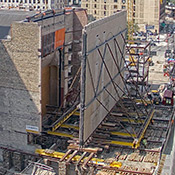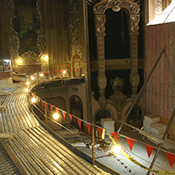
Grand Theater Restoration Update: September 2018
David Lewellen
PUBLISHED
Tagged Under: Grand Theater, In the News, Support
Two years remain before the Milwaukee Symphony moves into the Warner Grand Theater on Wisconsin Avenue. Right now, the theater is a busy and active construction site. But even with dim light, construction debris, and a thick layer of dust, a tour makes it surprisingly easy to visualize the spectacular concert venue that will emerge.
Start in the construction trailer parked near Wells Street. Sign in, put on your green fluorescent vest, safety glasses, and hard hat with the MSO logo. Walk across the wet, unpaved lot behind the building, which will probably become a valet parking lot.
Standing within the construction barrier on Second Street and craning your neck, you see The Wall – the one that will have to be moved intact, inch by inch, 35 feet outward, in order to create a deep enough stage for an orchestra. A 1930s Art Deco movie palace didn’t need much of a stage at all. But that was the building’s original use – and preserving The Wall is vital to obtain historic preservation tax credits, which in turn are vital for the project’s funding.
Already, pieces of decorative terra cotta are being systematically removed for preservation and cleaning, stacked on pallets in the street. Moving the whole structure will probably wait until next year, and the new, narrower Second Street will become a one-way, going south.
Next to The Wall, at the corner of Second and Wisconsin, is a deep hole in the ground, about the size of a sushi restaurant – which was demolished earlier in the project. Eventually, it will become a glassy atrium, for gatherings before and after concerts, with a skylight for better viewing of the Richard Haas mural that covers the office tower above the theater. The mural, painted in 1981, is not considered historic, but it is certainly decorative.
Walk around the corner and see the marquee of the old theater, which will eventually advertise the MSO, and the old ticket office, which will become a valet parking booth. Walk inside, smell the dust and damp, and take in the dingy, faded splendor, waiting to be cleaned up for modern audiences. The chandeliers have been shipped off to St. Louis for cleaning and restoration; the water-damaged mural on the landing will be restored; the plaster is in good shape; some of the silver leaf may need a touch-up.
The theater is oriented east-west, meaning that concertgoers who walk in from the street will go through the grand lobby and then make a right turn to reach their seats. For now, the hall is empty, stripped down to the concrete, which is being loudly taken out with jackhammers. Eventually, new, wider seats will be put in – with aisles. No more pushing past 20 or 30 pairs of knees to reach your seat.
Walk up the grand staircase to the balcony, with unique architectural features that must be preserved. The men’s “lounge” (apparently it wasn’t a “restroom” in the 1930s) contains a fireplace, as well as some old plumbing that will be upgraded. The phone booths that modern audiences don’t need will be converted into listening booths.
Inside the hall, the balcony is being also regraded and reseated. The very front section will become 120 box seats, the same as the Marcus Center. Main floor and balcony will each hold about 800 seats, with 150 more behind the orchestra, for sale to the public for concerts that don’t require a chorus.
Another grand staircase leads to the third floor, where audience members at the top of the balcony can be seated. The MSO will also own the small office tower above the theater; that space will be used for music library, chorus rehearsal and warm-up space, and administrative offices. The top six floors will be brought up to code, but no immediate use is planned for them. (Fortunately, the symphony is under no obligation to restore the office space to the way it was in the 1930s.)
Compared to the visible, noisy work of construction, fundraising so far has been quiet – but equally effective. Campaign manager Celeste Baldassare said that so far, in the major-giver phase, the symphony has raised $111.7 million of the $139 million goal. Of that $139 million sum, $89.9 million is for the construction and restoration work; the rest will be used for pension funding and increasing the endowment. Everything will work together to put a revitalized orchestra in a revitalized building.
Grand Theater construction photo by Jonathan Kirn, Aug 2018. View more photos at facebook.com/MSOrchestra.



